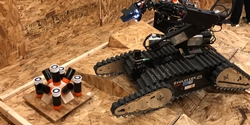Putting Food Safety First With Robots - Could Robots Lead the Fight Against Contamination in Food Production Lines?
The Colossus Robot on the Front Line Against Covid-19
How to Improve Worker Safety Around Robotics
Food Safety in Large Scale Picking of Produce
5 More Ways Robots Keep People Safe
Maintenance Free UR Cobots Operate Continuously in Harsh Environment
Automate for Accident Reduction
Practicalities of Small Collaborative Robots
Addressing Safety when Introducing Cobots to the Workforce
SICK is taking safety to the next level with collaborative robot systems
University of Texas "opens Doors" to Safer Nuclear Waste Retrieval
Robots & Humans Cooperating and Coexisting in the Future
RoboCup 2018: S&T Test Methods Used to Evaluate Rescue Robots
Safe Cut
Collaborative Robots and Robot Safety
Records 16 to 30 of 43
First | Previous | Next | Last
Featured Product
















